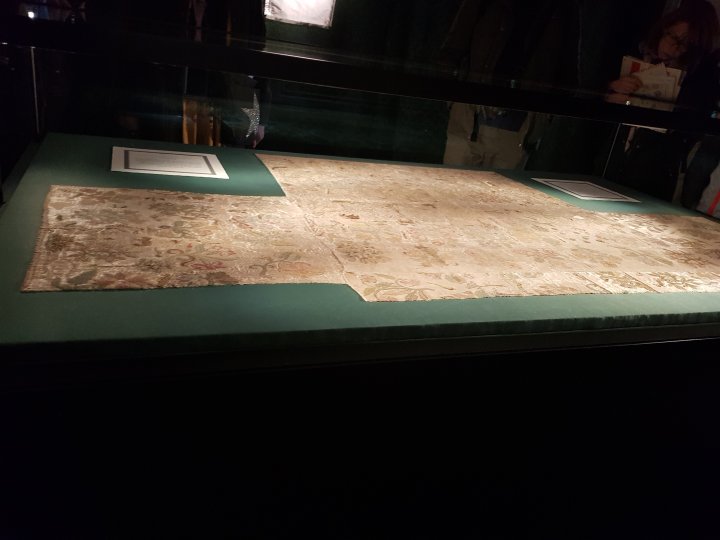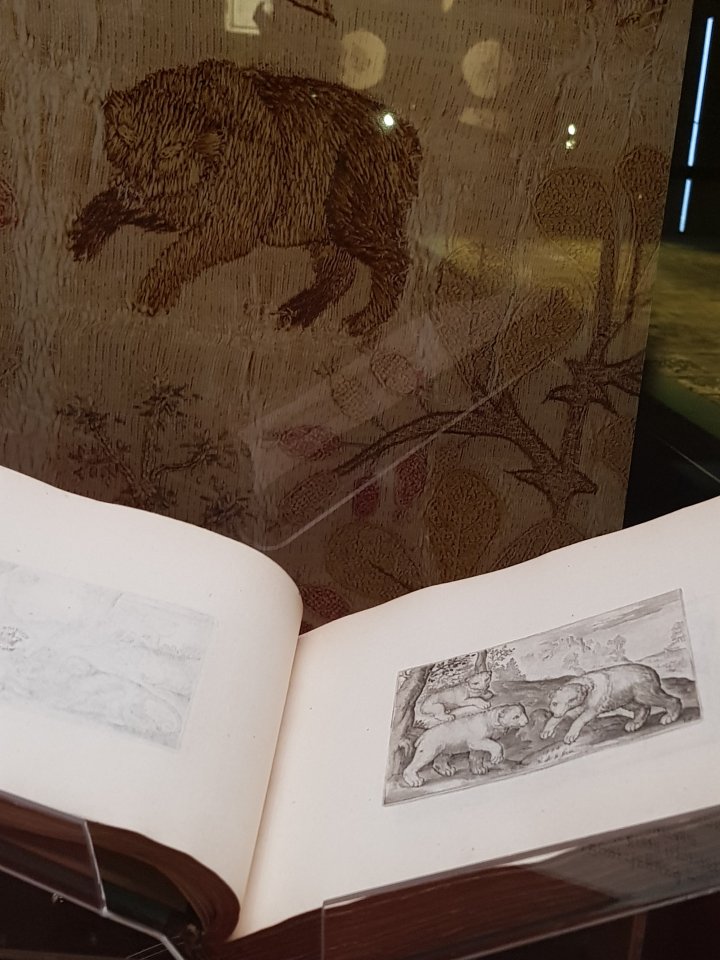On display at Hampton Court Palace since 12 October is the Bacton Altar Cloth, kept for centuries in the small village church, St Faith’s, Bacton, Herefordshire, England. Bacton was the childhood home of Queen Elizabeth I’s favourite gentlewoman and life-long confidente, Blanche Parry. There is a memorial to Blanche in the church, but she is actually buried at St Margaret’s Church, Westminster.
This is a special exhibition and is scheduled to last until 23 February 2020.
There is no written provenance of the Altar Cloth, but having been examined by expert historians, it is believed to be of superior quality, of a type that only royalty or the highest nobility would wear.

The last Tudor monarch was known to give clothing that was no longer required to trusted servants and records show that Blanche Parry did receive such items. It has been dated to the years after Blanche’s death, not long before Elizabeth’s own death. Incidentally, when Queen Elizabeth I died in 1603, her inventory listed 1,900 dresses.
How did it end up in Bacton? It is thought that Queen Elizabeth I may have sent it to the village in memory of Blanche, who served her mistress from a small baby to long into her reign.
Eleri Lynn, Collections Curator at Hampton Court Palace, visited the Altar Cloth in situe four years ago whilst researching a book on Tudor fashion. She was immediately excited by what she saw.
Tudor law stated that only those of very high social status, such as nobles and royalty were permitted to wear clothes containing silver and gold.
The fabric has been painstakingly conserved by experts and its uniqueness as a rare object of Tudor fashion is, to me, awe-inspiring.
The title of this blog post is slightly misleading – and I don’t apologise for that! If Historic Royal Palaces can call it ‘Elizabeth I’s lost dress’ – then so can I! For the Altar Cloth doesn’t look much like a dress these days. However, the Altar Cloth itself is almost cruciform in shape and is made of ‘high-status silver chamblet silk, with professional embroidery of silver and gold thread’. Evidence suggests that it was subject to pattern cutting demonstrating more ties to elite court fashions. Dyes used were sourced from India and Mexico, the ‘New World’ only a recent European discovery at the time and would have cost vast amounts of money to purchase.
The fabric is decorated with high-quality scenes of the natural world, multiple birds, insects, a bear, a toad and a stag can be seen. It also conveys a story of fishermen in a boat, a whale that attacks the fishermen and boat, and then the empty boat. The cloth also bears a mythical image of a dragon attacking a snake. It’s fascinating – and all the more so as one of the source documents has been located and in which you can compare the image of the bear, which is almost identical to the one embroidered on the fabric.

The Bacton Altar Cloth is displayed in semi-darkness to protect it from the light and it’s staggering that more than 400 years after its completion, the colours are still clearly identifiable. For more than 100 years it was kept inside a glass frame and placed on display on one of the walls of St Faith’s, thankfully, the church has naturally reduced light and it was not damaged overmuch.

Also on display is the ‘Rainbow Portrait’ of Elizabeth I, painted around 1600-02. This portrait depicts the Queen wearing a dress that is startlingly similar to the Bacton Altar Cloth and if not the same object, shows evidence of Tudor fashions and fancies for natural history that is contemporaneous to the Bacton Altar Cloth.
Once again, I’m really thankful I live close to Hampton Court Palace and that I’m making use of my Historic Royal Palaces annual membership.









It has always been a wish of mine to visit England. Sadly at my age I realize that will not happen but I love seeing this beautiful cloth and hearing the story behind it.
LikeLiked by 1 person
If you visit HRP’s website – I forgot to link it as a source – you can see a 5 minute film about it. http://www.hrp.org.uk It’s a wonderful display at HCP but you will find out more on their website. x
LikeLiked by 1 person
Thanks for the link.
LikeLiked by 1 person
Wow, I love it! So beautiful and so incredible that something so old can be in such good condition. Thank you for sharing.
LikeLiked by 1 person
It’s amazing. I was hugely excited. The workmanship is incredible.
LikeLike
I can imagine the texture. So luxurious.
LikeLiked by 1 person
It’s fabulous! The detail in the fabric is amazing.
LikeLiked by 1 person
How awesome!! Seeing the actual fabric is so much more impactful than seeing it in a portrait!
LikeLiked by 1 person